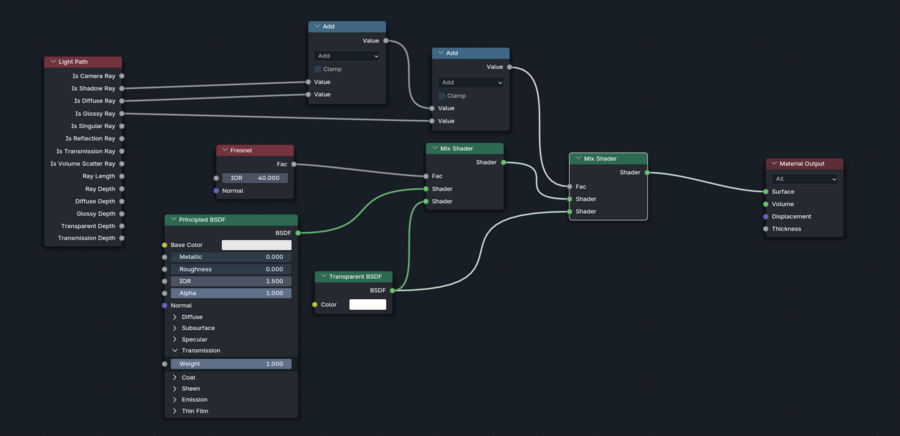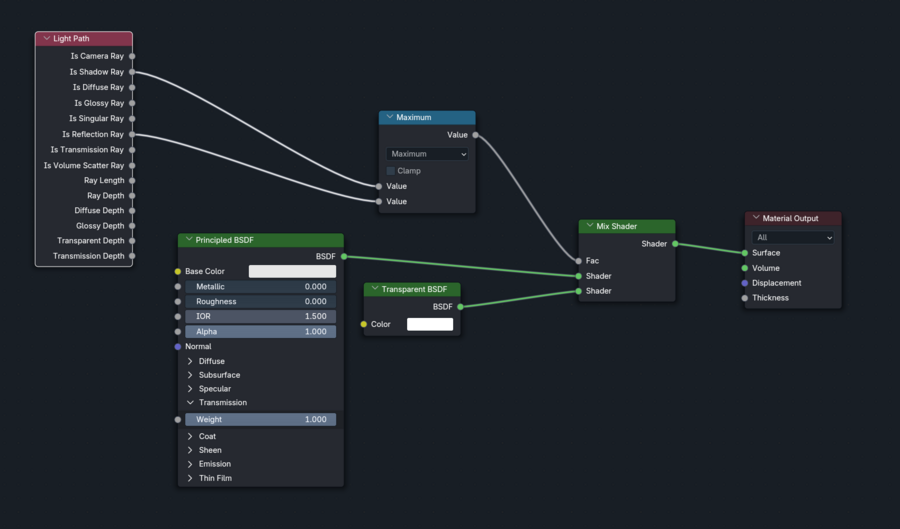Archviz Glass: Difference between revisions
From MC Animation and Rendering Wiki
More actions
Standingpad (talk | contribs) Created page with "Archviz glass refers to shaders whose surface has the properties of glass, but without refraction. It's commonly used for windows in archviz rendering, where regular glass shaders may create additional noise for interior scenes." |
Standingpad (talk | contribs) Added new example setup to the Blender Section |
||
| (3 intermediate revisions by the same user not shown) | |||
| Line 1: | Line 1: | ||
[[Category:Shaders]] | |||
Archviz glass refers to shaders whose surface has the properties of glass, but without refraction. It's commonly used for windows in archviz rendering, where regular glass shaders may create additional noise for interior scenes. | Archviz glass refers to shaders whose surface has the properties of glass, but without refraction. It's commonly used for windows in archviz rendering, where regular glass shaders may create additional noise for interior scenes. | ||
== Examples == | |||
The following are some examples of archviz glass shaders for each program. | |||
=== Blender === | |||
==== Setup with Fresnel Node ==== | |||
This setup<ref>https://www.youtube.com/watch?v=KyXRBu7gn2o&t=300</ref> uses the [[wikipedia:Fresnel_equations|Fresnel effect]] alongside light path tricks, which may create more pronounced reflections. | |||
[[File:Blender archviz shader ex 1.png|thumb|center|upright=3.0|alt=Example of an Archviz glass setup in Blender using a fresnel node]] | |||
==== Setup with the Maximum between Shadow and Reflection Rays ==== | |||
This setup<ref>https://docs.blender.org/manual/en/latest/render/cycles/optimizations/reducing_noise.html#glass-and-transparent-shadows</ref> uses maximum of the ''Is Shadow Ray'' and ''Is Reflection Ray'' values to make the surface rendered as glass, but the indirect light rendered as a transparent shader. | |||
[[File:Blender archviz shader ex 2.png|thumb|center|upright=3.0|alt=Example of an Archviz glass setup in Blender using the maximum between the shadow and reflection rays.]] | |||
Latest revision as of 21:58, 5 July 2025
Archviz glass refers to shaders whose surface has the properties of glass, but without refraction. It's commonly used for windows in archviz rendering, where regular glass shaders may create additional noise for interior scenes.
Examples
The following are some examples of archviz glass shaders for each program.
Blender
Setup with Fresnel Node
This setup[1] uses the Fresnel effect alongside light path tricks, which may create more pronounced reflections.

Setup with the Maximum between Shadow and Reflection Rays
This setup[2] uses maximum of the Is Shadow Ray and Is Reflection Ray values to make the surface rendered as glass, but the indirect light rendered as a transparent shader.
